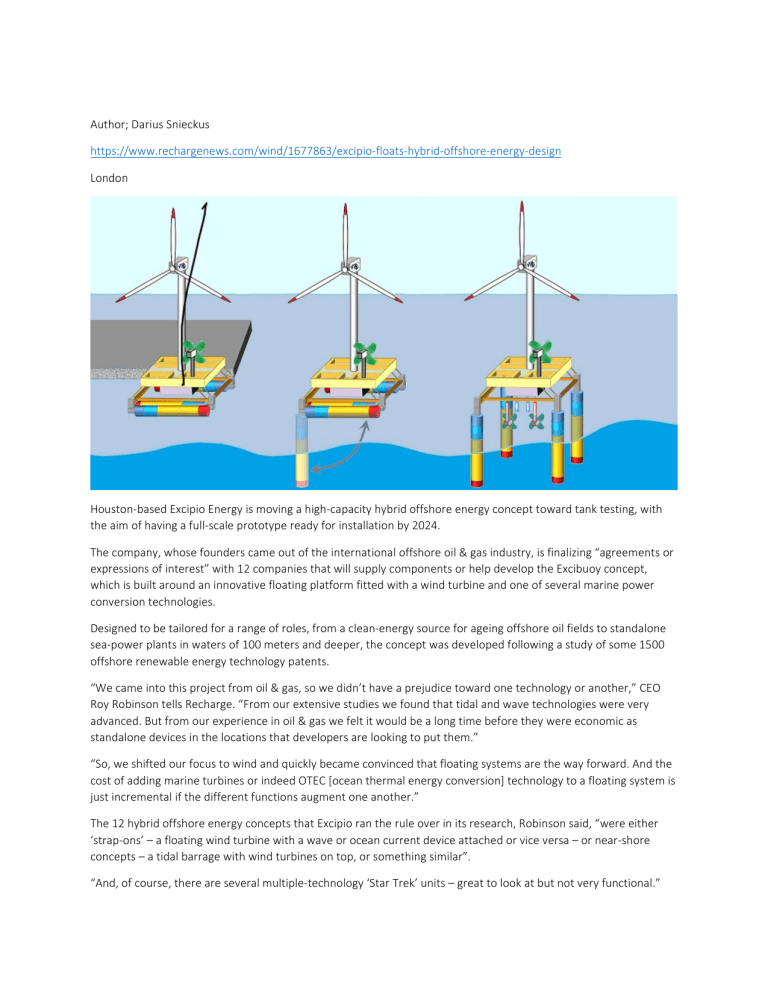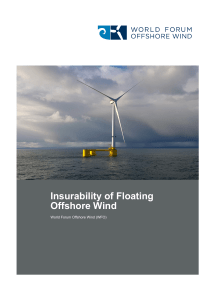
Author; Darius Snieckus https://www.rechargenews.com/wind/1677863/excipio-floats-hybrid-offshore-energy-design London Houston-based Excipio Energy is moving a high-capacity hybrid offshore energy concept toward tank testing, with the aim of having a full-scale prototype ready for installation by 2024. The company, whose founders came out of the international offshore oil & gas industry, is finalizing “agreements or expressions of interest” with 12 companies that will supply components or help develop the Excibuoy concept, which is built around an innovative floating platform fitted with a wind turbine and one of several marine power conversion technologies. Designed to be tailored for a range of roles, from a clean-energy source for ageing offshore oil fields to standalone sea-power plants in waters of 100 meters and deeper, the concept was developed following a study of some 1500 offshore renewable energy technology patents. “We came into this project from oil & gas, so we didn’t have a prejudice toward one technology or another,” CEO Roy Robinson tells Recharge. “From our extensive studies we found that tidal and wave technologies were very advanced. But from our experience in oil & gas we felt it would be a long time before they were economic as standalone devices in the locations that developers are looking to put them.” “So, we shifted our focus to wind and quickly became convinced that floating systems are the way forward. And the cost of adding marine turbines or indeed OTEC [ocean thermal energy conversion] technology to a floating system is just incremental if the different functions augment one another.” The 12 hybrid offshore energy concepts that Excipio ran the rule over in its research, Robinson said, “were either ‘strap-ons’ – a floating wind turbine with a wave or ocean current device attached or vice versa – or near-shore concepts – a tidal barrage with wind turbines on top, or something similar”. “And, of course, there are several multiple-technology ‘Star Trek’ units – great to look at but not very functional.” The Excibuoy, by contrast, he adds, is designed to be “buildable, practical and to be installed anywhere in the world’s waters by tailoring the combination of component systems”. The design, which uses a 60-metre x 60-metre square steel platform with hinged spar-shape legs some 80-metres in length, could incorporate “a wide variation” of power-producing elements, including ultra-large wind turbines, oscillating water column or point absorber wave energy devices and OTEC system, to generate all-in output of 2030MW per Excibuoy. By Excipio’s calculations, this production could translate into a 25% improvement in levelized cost of energy “compared to a similar-sized floating wind system”. Excipio has modelled installations of different versions of the design in “most every region of the world you can imagine”, says Robinson, but narrowed it to several optimal locations for first demonstrator projects, including a wind-OTEC design in 2,000-metres of water in the Gulf of Mexico that would power a subsea oil & gas field and another standalone wind-ocean-current unit in water depths of 200-metres in the northern Atlantic. “The ‘best locations’ for us would be down to the economics of the different business cases – wind-wave-OTEC makes sense in certain areas like the US Gulf, wind-wave-current off the US north-east – and if West of Africa, for instance, then perhaps a design that harnesses OTEC and deep water ocean currents because wind and wave resources are rather benign,” adds COO Georg Engelmann. “It’s about keeping the same basic design but considering how best to convert a unit to site and resource conditions to best tap the power available.” The Excibuoy is engineered with a sharp focus on construction and installation: a wind turbine can be mated in-port with the spar legs folded under the platform during assembly before tow-out to site for mooring, meaning there is no need of an expensive heavy lift vessel offshore. “We are looking at this very holistically, systemically,” notes Robinson. “There is no question that the engineering is sound, it will work. The only question is how much more power will these units produce than wind alone. Excipio is now fund-raising to move into a 18-24 month program of tank-tests and modelling to confirm the integrated performance, with a view to then building the full-scale prototype.






